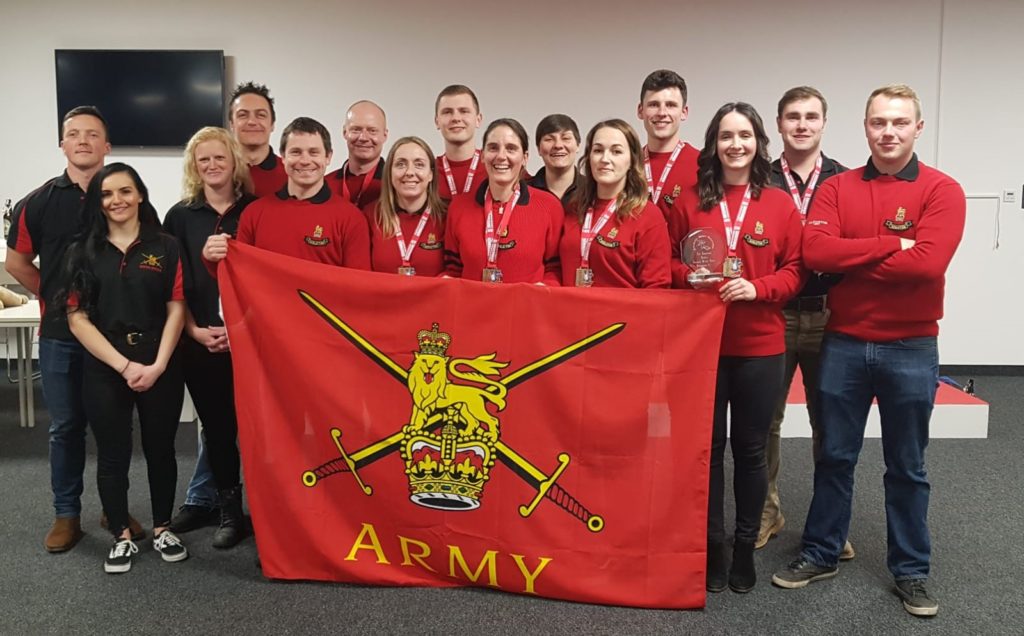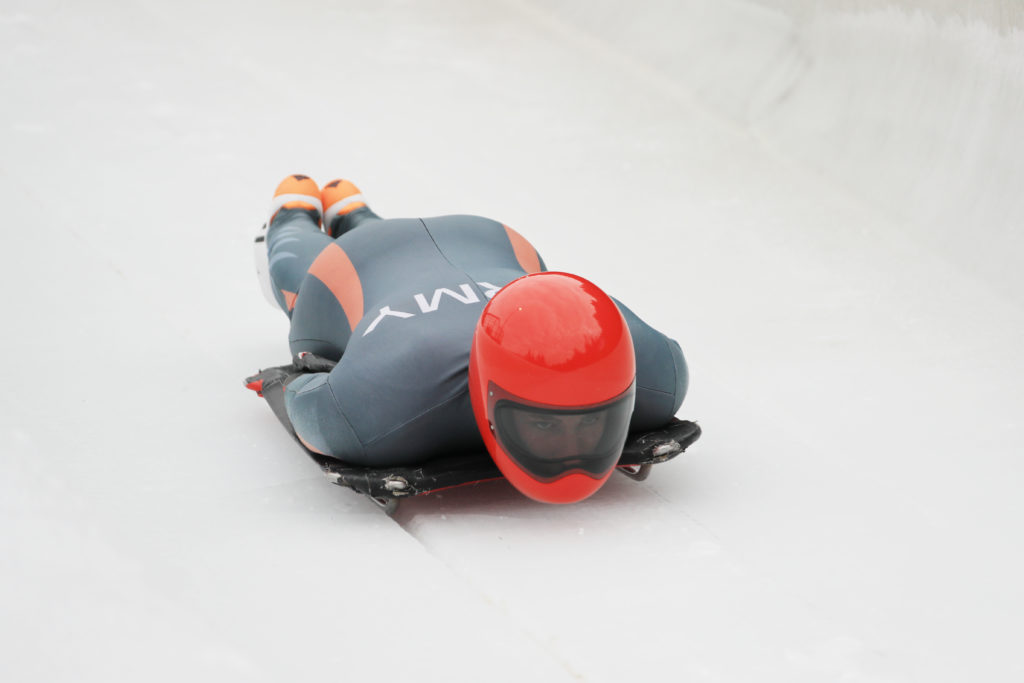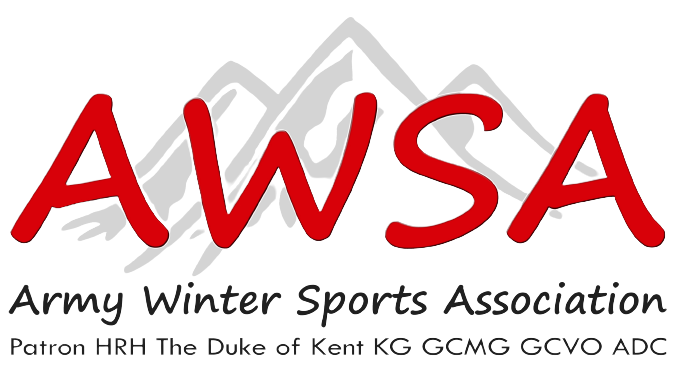Skeleton is available to both Regular and Reservist soldiers and is becoming more popular every season. The race begins with a running push start from the top of the track; a fast start is crucial for success. Races can be won or lost; pace, explosive power and skill to move the sled as quickly as possible and leap on. The clock does not start until they reach the 15m point. The fastest start titles from the ‘Army Championships’ were from Capt Rhiannon Graham AGC who for another season won the Women’s title, and in his Novice Season 2Lt James Folkes who won the men’s.

Once the athlete is on the sled, focus and fast reflexes to manoeuvre the curves of the track is key as well as having the discipline to maintain the most aerodynamic position. It does not take long to reach great speeds and experience up to 5Gs; all whilst their head and feet hang just over the sled, and on high speed corners their helmet can touch and scrape the ice due to the excessive speed, pressure and Gs. This can of course be tricky for the athlete as they can have obscured vision and will therefore have to feel their way around the corners until the pressure is reduced, not an easy task. Constant track walks and analysing track notes is a must for all athletes, no matter what level or experience they have.
Whilst steering the sled it is vital that the athlete only moves when needing to steer, otherwise any slight movement at high speed will change the direction of airflow past them causing the sled to unintentionally move. This can have a dramatic effect to the success of the run and would increase their overall down time and effect the overall finish position. If they wish to steer the sled they can shift body weight, apply downward pressure using knees and shoulders on one of the corners of the sled. Reaching out and tapping a toe can also alter the direction in which they wish to turn. Every soldier that attends Ex RACING ICE 1 – novice camps will take part in a progressive training week that will allow them to learn the basic detail, steering and the running starts.
There is not much personal kit needed for Skeleton. The Helmets are specialist race helmets that need to be strong to withstand impact but also light enough for the high-speed corners when they are experiencing high Gs. Skeleton spikes differ from normal running spikes as they are brush like and contain 300 needle-like spikes so that the athlete can grip the ice at the start and push the sled with maximum power and pace. Both the helmet and spikes are provided for all Army personnel that take part in skeleton. The race suit has been developed to be the most aerodynamic, it is a tailored fit so that no loose material will slow the athlete down. Padding is not a requirement, but a must for everyone on Army Novice Camps.
Ex RACING ICE 1
Ex RACING ICE 1 was again held in Igls, Austria. The novice camp allows both Regular and Reserve soldiers the chance to take part in one of the three ice sport disciplines available; Skeleton, Bobsleigh or luge for a period of one week. Everyone that attends are volunteers and containing nerves, excitement and adrenaline on an Olympic track whilst experiencing speeds of 100 Kph is not for the faint hearted. This did not deter the novices this season with an impressive increase in female soldiers attending and both weeks were fully attended.
After a short flight from Gatwick the novice athletes arrive at the Waltzl, a small and friendly hotel located just outside the city of Innsbruck in a town called Lans. The Army has stayed here for many years and the host is very accommodating.
Everyone who arrives has a nervous but excited demeanour about them. Most have watched their chosen discipline on TV, Youtube or other social media.
After the arrival brief by the Exercise OIC athletes are introduced to their Discipline heads and coaches. This season the Skeleton training team was solely military; coaching and training for the week was led by SSgt Nicky Moxon assisted by SSgt Mel Vernon and Cpl Dave Manning and for the second week SSgt (SSI) Julia bloomer. All team members have a vast amount of experience and reassured the Novice athletes that they were in safe hands. We also had excellent trackside medical cover from Sgt Natasha Sinclair and Cpl Dave Hummel.
Once all briefs had been given the groups were taken to the Olympic track. On first viewing it is no ordinary feeling stood next to the finish curve, when an athlete speeds past headfirst. Conversations fill the air and are mostly ‘that cannot be what I will be doing, tomorrow?’ or ‘how will I slow myself down’. The first answer is a definite yes, and sorry there are no brakes on your sled!
Next stop the novices are introduced to the personal protection equipment – helmet and spikes. Excitement and nerves are visible when given the sleds that will be taking them down the track. The amount of padding everyone brings with them is plentiful. Whilst it is a requirement for the Novices, they can take on the appearance of a walking roll matt; too much can be a hindrance. Once all the equipment has been issued, the essential instruction and safety briefs given and a track walk completed, all are ready for the first day on the ice.
The breakfast prior to hitting the track on the first day of ice is always quiet. Some novices are tense and anxious about what the first trip down the track will be like, whilst others seem to be a little more confident. However, in Skeleton, feelings can change whether it is the first time on the ice or the slider has years of experience. Nerves and excitement can be difficult to manage. Who knows what they will be thinking before they leave the start? Calm and collected, maybe? Or not!
Day one at the track is when Novices learn how to control initial fear and how to react or not at speed. Everyone has masses of courage to travel into the unknown, no other sport compares. Two runs which are called laufs will be completed whilst the slider become best friends with their sled. At the end of the first day, another track walk is completed, coaching will be given with the focus on body position. It is amazing the difficulty a novice slider finds in keeping their head close to the ice with feet in the downward position.
Day two is when reality of the sport becomes apparent. They will be starting from further up the track. This is another fear to overcome as speeds will again increase and some will travel around the finish curve not aware of what has just happened or that they are at the end, this is going from an extra three bends closer to the top. Each slider has various ways to overcome this, whether they prepare on their own or in a group. Some are quiet whilst others are lively and excited. Every day warming up is vital as speed will be increased as well as the Gs. Over the following two days the majority of skeleton sliders become addicted to speed and want to push off the top as fast as they can to achieve at least 110KpH by the last day. On the last day the competitiveness kicks in, everyone gives 100%, sprinting off the top and safely completing the two laufs. The natural sliders become apparent with excellent run times and natural push starts. During Ex RACING ICE 1, Skeleton had some very promising novices both male and female who were invited to attend the following Army championships. Building on the successes at the Championships, four novice sliders were then selected to be part of the Army Squad at the Inter service Championships.
Ex RACING ICE 2
The venue for the 2019 Army Ice Sports Championships was to be Konigssee, which the Army last competed at in 2011. It was challenging, difficult to master and provided a level playing field for all competitors. The Championship was again at full capacity and ran by Maj Tim Haskell, SSgt Nicky Moxon and SSgt Mel Vernon. The Army Skeleton Championships had 23 high quality athletes with a wide range of abilities. Sport for all is highly encouraged and promoted during this event. A criterion for sliders wishing to attend the Championships is to safely complete the Novice week and to be invited back to attend the Championships. With a fine blend of novice, Junior and senior sliders, the title for Army Champion was not going to be easy an easy win. Any error can have a dramatic effect on a down time. Konigssee is a technical track and speeds of 130KPH can be easily reached.
The Championships includes four training days and final race day. Throughout training, for the first few laufs all sliders started at the S-Curves under the excellent instruction of Nathan Jackson. This allowed a steady progression as the 360 Krisel further down the track, had a vicious bite had to be taken at a slower speed to get this right before moving to the top of the track. By day four all sliders were at the top. The track also has an outside ice house – push track was available and many starts were practiced and perfected ready for racing. The race can be won on a sliders start, so any opportunity to practice is a must.
On the evening prior to the final day a Race draw is conducted and everyone awaits their position in which they will start their first lauf. This can have an effect mentally and the condition of the ice can change on the day as it can quickly deteriorate within minutes if the weather suddenly changes. Most want to slide in first position but on the second run the running order is from the slowest first to the fastest last. The race result is a combined time of both runs.
The male race this year was the most exciting yet as novices and junior sliders were keeping the senior sliders on their toes. The second run was tense, start times were getting faster, with 2Lt James Folkes leading the way with his impressive push start. The Army Championship title was fought for until the end, but with nail biting second laufs and a slight error on exit Krisel from Sig Arran Holmes, Pte Sam Banda won the championship followed by Cpl Ben McManus as runner up and Cpl Dave Manning in third. Two novices shone throughout the championships and both Cpl Daryn Smith and Maj Ross Catchpole were subsequently invited to be part of the Army Squad.
The quality within the Female race was again at the highest with new novice and junior sliders keeping the more senior sliders aware that the race wasn’t won yet. On race day, experience paid off for the senior sliders even though the Krisel was catching some of the sliders out on the exit. However Capt Rhianon Graham led from her first run and won the Women’s title for the 2nd year, followed by senior slider, SSgt Maria Cullimore as runner up. A mention to the two novice sliders – Cpl Georgia Grossi, RA and Pte Rachel ford, AGC. Both demonstrated a vast amount of potential and were therefore selected to be part of the Army Squad and attend the Inter service Championships.
With all sliders giving it their all, selecting the Army Squad to go forward to Ex RACING ICE 3 and the Inter service Championships was a difficult task for the staff as it is imperative that the right squad is selected. Once squad selection has taken place, the next hurdle can be the availability of the selected sliders. Fortunately, this was not an issue and a big thank you to all the Chain of Commands involved in allowing their soldiers to compete at the highest level.
Inter Service Championships
For the first time since 2011 the Army Squad returned to Konigssee for Ex RACING ICE 3 and the Inter Service Championships. The Army Squad consisted of 13 sliders, 6 female and 7 Male. The first week consisted of training laufs, many track walks and analysing notes. From the Army Championships everyone was aware of how technical the track was and began to work on techniques to tackle Krisel and other problematic areas on the track. For the first week the Squad was kindly coached by Swiss coach Uls, he was great with all sliders and everyone progressed which was fantastic. This helped ensure that the RAF and NAVY teams were kept on their toes, especially as the RAF arrived with a current GB slider alongside a recent ex GB slider! At the inter service championships the race is conducted over two days and consists of four Laufs combined for each team athlete, so an error earlier in the race can be difficult to fix, therefore a race can be lost on the first lauf. However, this can create exciting Championships amongst the talented athletes from all three services and this season did not fail to impress.
After a successful seven days of training, the difficult task of selecting the team to race was upon the shoulders of SSgt Nicky Moxon, Cpl Dave manning and SSgt Mel Vernon. Again, the squad had masses of talent and this season the opportunity was given to two novices amongst a nine strong team. A special mention must be made to Sgt Tony Wressell and SSgt Mel Vernon, Cpl Dave Manning for their assistance and coaching.
This was an excellent experience for the Squad but it was clear by the end of the race that the RAF had taken the title with the Army Mens team as runners up. Pte Sam Banda gained an individual 3rd place and it was great to see that four of the Army athletes were in the top six. The Navy couldn’t catch the Army team and remained in 3rd.
The Female team was selected with a mix of senior and junior sliders. It was a close race and the last day was certain to count as after day one, all Army sliders had produced PBs, and sliders from all three services were within an inch of the title. On the second day the track conditions had changed due to bad weather this increased errors and places were swapping and changing until the end. However the experience that the Army team contained allowed them to take the Winners title back from the RAF as well as individually 2nd place was won by Army senior SSgt (SSI) Julia bloomer and 3rd place was achieved by Junior Sgt Amie Kirwin. Excellent results all round. Capt Rhianon Graham also kept her foot to the gas at the top of the track and won the fastest start title!
Throughout the past few seasons Army Skeleton has gone from strength to strength with a promising future ahead. The depth and knowledge of all sliders is being continuously developed. The opportunity for experienced sliders to become coaches has increased and plays a vital part to the success and development of future Army Skeleton athletes. Army Skeleton is evolving!
Interested? Do you have fast reaction times, physical and mental strength and a sense of humour if it all goes wrong then please contact SSgt Nicky Moxon, email skeleton@awsa.org.uk




